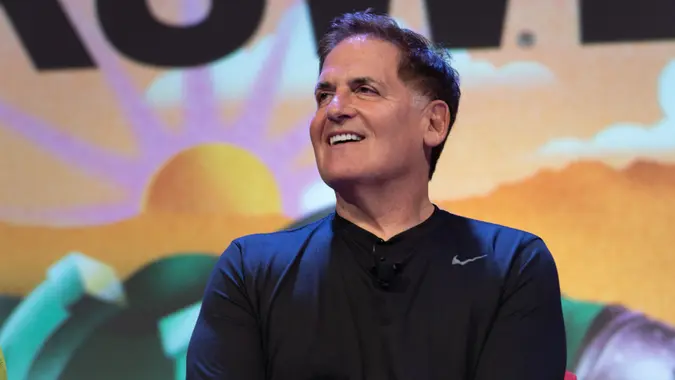The Ultimate No-Spend Challenge Guide To Saving Money Fast

Commitment to Our Readers
GOBankingRates' editorial team is committed to bringing you unbiased reviews and information. We use data-driven methodologies to evaluate financial products and services - our reviews and ratings are not influenced by advertisers. You can read more about our editorial guidelines and our products and services review methodology.

20 Years
Helping You Live Richer

Reviewed
by Experts

Trusted by
Millions of Readers
A no-spend challenge is a simple way to bump up your savings by committing to skip non-essential spending for a set period. People commonly try it out for a month, or 30 days, but you can choose any time period that works best for you.
How One Saver Used a No-Spend Month To Pay Down Debt
Jasmine Charbonier, founder of YourTampaBestie.com, completed a no-spend challenge in December 2023.
She decided to partake in a no-spend month for a variety of reasons.
“I was feeling stressed about my spending habits and wanted to get myself back on track financially,” she said. “I had racked up some credit card debt over the holidays and wanted to pay it down quickly.”
She said she wanted to challenge herself to see if she could go an entire month without any discretionary spending. To do this, she set strict rules for herself, including only spending money on essentials like housing, utilities and groceries.
“I did not allow any spending on dining out, entertainment, shopping — other than groceries — [or] experiences for myself,” she said. “I also did not allow any spending on my credit or debit cards during the challenge.”
Taking these drastic moves required her to make notable preparations.
“I meal planned for the entire month to avoid [the] temptation of eating out,” she said. “I selected movies [and] shows to watch at home for entertainment.”
She also told her friends and family about her no-buy month goals to gain their support and help with accountability.
“The first week was the most difficult, as I adjusted to the lifestyle change,” she said. “I found free activities like hiking local trails [and] reading at the library to fill my time,” she said.
To stay motivated, she tracked her progress in a notebook.
Ultimately, she said a main takeaway from the experience was the realization that she had been spending a lot of money unnecessarily, without even realizing it. However, that wasn’t the only lesson she learned.
“Completing this challenge helped me pay down a significant amount of debt that I had racked up,” she said. “It gave me a new perspective on mindful spending and saving habits that I aim to continue practicing long term.”
9 Tips From a No-Spend Expert
Deidre Cross, founder of Ohh You Budget, does a no-spend month twice per year, in May and September, to fast-track her savings targets.
“I have an irregular income, so some months bring in less, making it tough to contribute consistently to all my savings goals,” she said. “This method allows me to rebuild my sinking funds or save for something specific in one go.”
Here are the nine rules she follows when completing a no-buy month.
1. Know Your ‘Why’
It’s important to go into a no-spend month knowing why you’re doing it.
“Identify your motivation, whether it’s reducing debt, saving for specific goals like an emergency fund or a car or simply curbing excessive spending from the previous month,” she said.
2. Plan Your Meals
When you’re hungry and short on time, it can be easy to give up and opt out of cooking. Therefore, she said you need to prepare in advance.
“Avoid being tempted to break the challenge by ensuring you have meals planned and ingredients stocked at home, minimizing the urge to order takeout,” she said.
3. Tell Others What You’re Doing
“Inform your friends and colleagues about your challenge, and they might even help hold you accountable,” she said.
She said other people will find your commitment admirable.
4. Have a Goal
Your “why” is your motivator for a no-spend month, but she said you also need a specific goal to work toward.
“While your ‘why’ may be to fund your emergency fund, your goal could be saving $2,000 that month or achieving 21 days of no spending,” she said.
5. Have Fun
If the going gets rough, she said to remember your no-buy month won’t last forever.
“Enjoy the process and find creative ways to have fun without spending money,” she said.
6. Budget Your Necessities
While the name of the challenge implies you won’t be spending money for a month, she said to remember that doesn’t actually mean you’ll be eliminating all expenses.
“Ensure you allocate funds for groceries, transportation and other essential items that can’t be avoided for a month,” she said.
7. Know Your Triggers
Before starting the challenge, she said to think about certain situations or store promotions that may tempt you to spend.
“If a sale at a specific store triggers impulsive purchases, unsubscribe from their emails to avoid temptation,” she said.
8. Say No
“Informing others about your challenge becomes useful when you need to decline invitations or requests,” she said. “Politely remind them of your commitment, saying, ‘I’m doing a no-spend challenge this month, so I can’t participate.'”
9. Redeem Loyalty Points
“If you frequently shop at certain stores, take advantage of any accumulated loyalty points during your no-spend challenge,” she said. “Check your balances and consider redeeming them to offset expenses.”
This is a fun way to save even more, as she said nothing feels better than free.
“One major thing I learned from this experience is that I am forced to think more carefully about my decisions,” she said. “It makes me more aware of how I spend my resources, like time and energy, which spills over into better time management and more focused efforts in different parts of my life.”
She said her two no-spend challenges per year also teach her discipline, which helps in other areas of her life where she needs self-control.
“It really becomes useful in other aspects of life, helping me stick to goals, projects and promises — just like dodging those impulse buys in my shopping days,” she said.
A no-buy month might be hard, especially at first, but the benefits can outweigh the sacrifices. If you’re having trouble keeping your spending on track, taking part in this challenge might be a game-changer.
How To Structure Your Own No-Spend Challenge
There’s no right or wrong when it comes to a no-spend challenge, so there’s a lot of flexibility in how you reach your goal. You can create rules to suit your lifestyle and budget. These are some variations to the no-spend challenge that you can try:
7-Day No-Spend Mini Challenge
If you’re new to money-saving challenges, you could start small with the 7-day no-spend mini challenge. You’ll commit to seven days without spending anything on non-essentials. You can test your limits without feeling too overwhelmed by a full 30 days or longer.
30-Day No-Spend Month
The 30-day no-spend month means no spending for 30 days. Your only purchases should be essentials, such as bills, groceries or gas. Next, you’ll need to buckle down on entertainment, shopping or meal delivery and restaurants — or any area where you’re prone to overspending.
Weekday-Only No-Spend Rule
The weekday-only no-spend rule can be a good option if you do more of your spending during the week. For example, say you regularly order out for lunch at work. You could bring something from home or create a meal plan instead. You’ll have a little extra saved up, which you can use for a little splurge on the weekend.
Weekend Spending Freeze
If you’re one of the many who work for the weekend, then this might be the time to freeze your spending. Starting on Friday night and ending on Sunday night, you’ll avoid spending any money on takeout, shopping and entertainment. Nothing about your weekday routine changes, and now you’ve got a bonus of having a solid savings plan.
Checklist for Preparing for a No-Spend Month
- Essential vs. non-essential: Know what your essential vs. non-essential items are.
- Start and end date: Choose a start and end date, along with a goal amount to have saved.
- Stock up on essentials: Have your essentials ready before you begin, such as everyday household items.
- Back-up plans: Make a plan to avoid temptations. For example, do you spend a lot of money eating at restaurants? That could be one area to cut.
- Free options: Create a list of free activities and options. That way, you’ll still have something to look forward to.
- Have an accountability partner: It could be a friend, a family member, but the idea is to have someone help you stay on target.
- Track your progress: You could use a journal or a daily checklist to keep track of each no-spend day and mark any big wins.
Common Triggers and How To Avoid Them
Even though you’ve taken all the right steps to prevent extra spending, it’s easy to fall back into old spending habits. These are some of the common triggers to watch out for and what you should do to keep yourself on track.
Fighting Boredom
You might be used to retail therapy or going out to the movies as ways to pass the time or keep things lively. There are plenty of free activities to try, though, such as going for a walk, reading or visiting a local park.
Emotional Spending
You might be the type to respond to stressful situations with a little retail therapy. If you do find yourself doing this a lot, check in with yourself. Try talking with a friend, taking a walk or writing in your journal. Ultimately, you’ll want to find ways to clear the mind and find another outlet to release negative emotions.
Social Media
If you’re a regular consumer of social media, influencers have a way of making the products or activities they review the be-all, end-all. You end up spending money as a result. It might be a good idea to take a social media break for a while so that you’re not inundated with all of the advertising. You can unfollow those accounts, use apps that will limit your time on social media or delete the platforms entirely.
How you spend and what you’re purchasing is personal to you, and so knowing what your triggers are is the first step to being successful at a no-spend challenge. You’ll have the bonus of building better money habits too.
Final Take: Why a No-Spend Challenge Is Worth Trying
A no-spend challenge can feel overwhelming, but getting started may be only half the battle. Plus, you’ll have a chance to bump up your savings and start new and better habits.
It’s OK if things aren’t always smooth during your challenge. You’ll be surprised — and glad — that you’ve started. You may feel accomplished and have newfound confidence once you have more control over your finances.
Start small and pick one week to try a no-spend challenge. Track your progress and see what you learn. Your budget — and your mindset — might thank you for it.
No-Spend Challenge FAQ
Here are the answers to some of the most frequently asked questions about the no-spend challenge.- What is a no-spend challenge?
- The no-spend challenge is a personal goal you create where you freeze spending for a set period. The duration is your choice, but doing a week or a month is the most common. During that time, you will only buy essentials.
- How do I stay motivated on the no-spend challenge?
- To stay motivated on a no-spend challenge, make sure you've got goals and targets in place before you start. Have all of your essentials ready, so you're not having to buy it during the challenge period. Also, keep track of your progress each day and celebrate any milestones you hit.
- Can I do a no-spend challenge with a family?
- You can do a no-spend challenge with family. Some ideas include sharing goals, coming up with ideas for free activities and meal planning.
- Is it realistic to do a no-spend challenge long term?
- You can do a longer no-spend challenge if you like, but the idea is to reset your habits and start on a new savings journey. Most people keep the no-spend challenges short so that they give themselves to build new money habits.
Melanie Grafil contributed to the reporting for this article.
Our in-house research team and on-site financial experts work together to create content that’s accurate, impartial, and up to date. We fact-check every single statistic, quote and fact using trusted primary resources to make sure the information we provide is correct. You can learn more about GOBankingRates’ processes and standards in our editorial policy.
- Fidelity. 2025. "How to do a no-spend month."
 Written by
Written by  Edited by
Edited by 

























